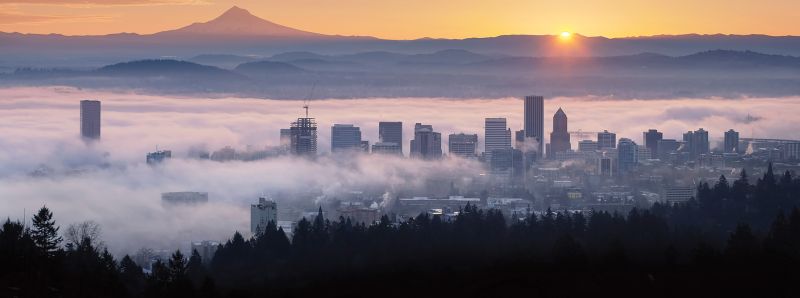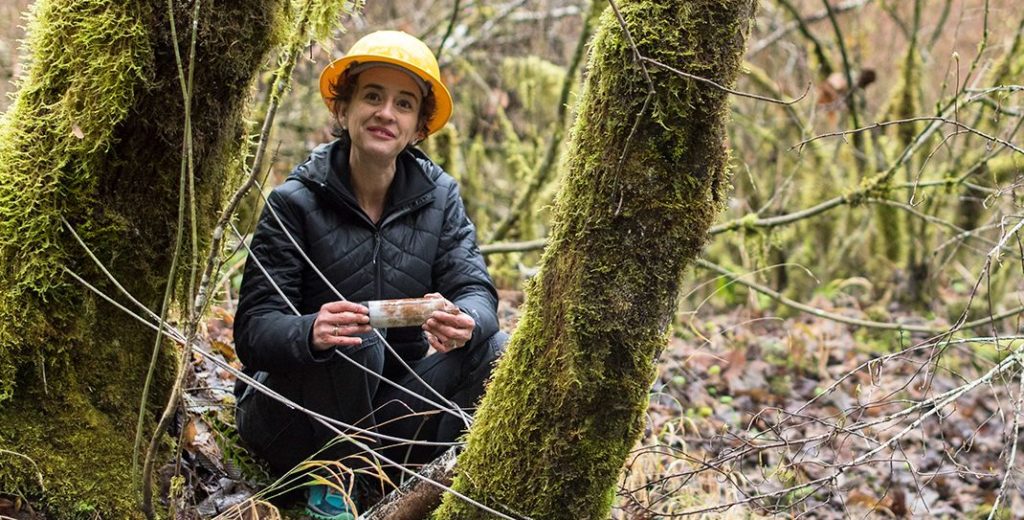Working at the crossroads of industry and community.
Assistant Professor in Forest Policy, Mindy Crandall, grew up in the Oregon Coast Range town of Otis on the edge of the Siuslaw National Forest. For recreation, she and her family camped in clear-cuts, rode dirt bikes and hiked steep trails through towering Douglas-firs.
“It was kind of my playground. There were no other kids close by. It’s the most beautiful place in the world,” she says.

And yet something nagged at her, a question that crystallized after she moved away. Why was it, she wondered, that the national forest looked so different from nearby privately-owned land?
Exploring that question led her to an undergraduate degree from the College of Forestry and a master’s and Ph.D. in Applied Economics from OSU (“I’m a triple beaver”) in 2016.
While she found the biology and ecology of forests fascinating, it was the human element that captured her imagination. “It’s all about people and their interactions with forests,” she says.
Crandall moved across the country to pursue that topic in a tenure-track position at the University of Maine (before getting her graduate degrees, she had worked as a VISTA volunteer in Maine for two years). She returned to Oregon State in January 2020.
“What motivates my research is the intersection of forests, rural communities and working landscapes. That’s where my heart lies,” she says. “How can we sustain a proper forest industry, and how can rural communities survive? These are treasured places of knowledge and experience. Somehow we need to figure out a way for all these things to work together. What are some of the slam-dunk things that are going to help rural places?”
In her efforts to illuminate the social and economic systems that shape forest-based communities, Crandall has looked at the forest industry workforce, alternative uses for biomass, and the relationship between the landscape and land management decisions.
For example, in Maine, she led surveys of businesses and youth to evaluate students’ interests in developing skills that match with forest industry employer needs. Crandall’s team found that students’ skills and expectations aligned with the culture of future potential employers.
In another study, Crandall looked at the relationship between regional landscapes and forest management. Her team identified factors such as tourism, exurban development, infrastructure, and commuting patterns that shape private landowner decisions and affect surrounding communities and landscape structure.
A project that harkens back to Crandall’s youth is “near and dear to my heart,” she says. The Rural Youth Futures Project surveyed high school students in two rural counties — Piscataquis County, Maine, and Coos County, Oregon — and was co-managed by fellow College of Forestry alumna Jessica Leahy. The goal was to evaluate the needs and opportunities facing youth growing up in rural forest-dependent communities.
“This comes out of my own experience growing up in the Coast Range, where there didn’t seem to be a lot of opportunities,” says Crandall. “We wanted to look at how kids think about the economy and the environment, how they perceived their communities, their outdoors, and whether they wanted to stay in rural areas or move away.”
An advisory committee of community leaders in both states helped to determine the questions and connect with schools. The project generated more than 2,000 survey responses. Crandall and her team found that youth have high educational aspirations and a high degree of place attachment to the outdoors. Publications are in process.
“Mindy wants to have a positive impact on rural communities that are challenged by the changes affecting forest-based economies,” says Claire Montgomery, retired chair of FERM and a forest economist. “In all my work with her, her concern for fairness and justice shines through. That passion is manifested in her research program and her commitment to programs that support diversity, equity, and inclusion.”
A prime example focuses on gender in forestry education. “When I started at OSU 20 years ago in forestry,” says Crandall, “it was about 10% women students, and it’s still about 10% women. Why have we made no progress? Female undergrads are often the only women in their classes.”
Conversations with Maine colleagues and students led to the formation of a group called Supporting Women in Forestry Today, or SWIFT. The group held social and professional events, which became places where people to get to know each other. Education, networking and strategizing for undergraduate women were its priorities. Although the pandemic has curtailed face-to-face gatherings, Crandall is considering ways to apply the lessons of SWIFT in Oregon.
In upcoming research, she is collaborating with Jeff Kline, a U.S. Forest Service economist, to study the community impacts of severe wildfire. “I loved living in Maine, but I’m happy to be back home in Oregon,” she says. “The landscape and politics of the West are so interesting — public lands, the rural landscape. It’s so fascinating. There’s so much to explore.”
A version of this story appeared in the Fall 2020 issue of Focus on Forestry, the alumni magazine of the Oregon State University College of Forestry.








